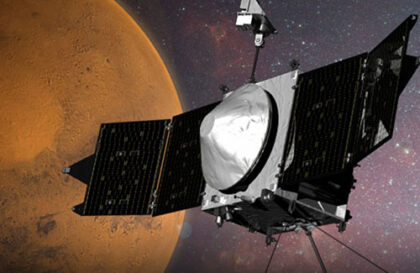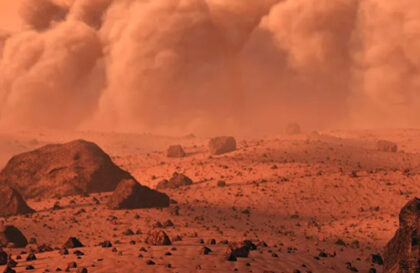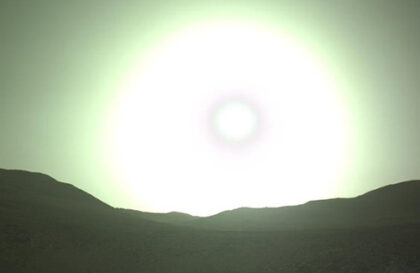A few salty water droplets that hit the rack of NASA’s Phoenix lander as it landed on Mars in 2008 caused scientists to reconsider the possibility of liquid water at high latitudes on Mars. At the time, this conclusion was the subject of discussion.
Previously, scientists have speculated that only solid or gaseous water could exist on the Red Planet, based on evidence suggesting drastic climate changes that have dried up what are thought to have been vast reserves of liquid water in the planet’s ancient history.
Despite our discovery of frozen water, Mars’ atmosphere is too thin, making the possibility of liquid water on the planet extremely unlikely.
Where does the wind blow from?
Scientists knew about the presence of dense ice caps at both poles of Mars, similar to those on Earth. However, unlike our ice caps, which hide water channels and subglacial lakes underneath, the Martian ice caps were thought to be frozen to the ground due to the planet’s cold climate.
On Earth, scientists have noticed that the shape of the top layer of the glacier depends on the presence of water under it, and this observation confirmed the results of the radar study of Mars.
The shape of these ice caps has been the subject of independent research to validate the radar data.
Water under the ice cap
In 2018, the Mars Express orbiter launched by the European Space Agency discovered interesting features on the surface of the ice cap covering the south pole of Mars. These observations indicated that the surface of the ice cap was changing, rising and falling, which could indicate the presence of liquid water underneath. However, the scientific community is divided on this issue.
Because Mars is a notoriously cold planet, the existence of liquid water on its surface requires a heat source such as geothermal activity. In this regard, many scientists have questioned the fact that the strange radar signals recorded by Mars Express could be caused by liquid water, and offered alternative explanations, such as the presence of dry material under the ice caps.
Mars Global Surveyor Discovered Patterns
More recently, an international team of scientists led by experts from the University of Cambridge conducted a study of the region covered by the ice cap, known as Ultimis Skopili, using an alternative methodology. Their research led to the belief that the presence of liquid water under this ice cap is the most likely explanation.
Using a laser altimeter aboard NASA’s Mars Global Surveyor satellite to map the top surface of the ice cap, the researchers found interesting patterns in the area’s topography. They found subtle, undulating changes in surface elevation extending from 6.2 to 9.3 miles (10 to 15 kilometers). These phenomena included depressions in the ice surface followed by elevations, each several meters above the level of the surrounding ice cap.
This geometry is reminiscent of the undulating ledges and depressions that often form over subglacial lakes on Earth. This is because the presence of water in subglacial lakes reduces the friction between the lake bed and the ice sheet, which allows the ice to move faster under the influence of gravity. These changes in the speed of ice movement appear on the surface of the ice cap in the form of depressions and their corresponding elevations that propagate along the ice flow.
Is there geothermal heat on Mars?
To confirm this link and evaluate the possibility of subglacial water, the researchers ran complex ice flow simulations adapted to the specific conditions of Mars.
In a computer model of the Martian ice sheet, they introduced zones of reduced friction on the bottom, where the presence of water could accelerate the movement of ice. In addition, the scientists adjusted the geothermal heat parameters in their model.
This simulation resulted in the formation of waves on the surface of the simulated ice, which were similar in size and shape to the observed features of the actual south polar ice cap on Mars.
Combining the results of this model, the new ice cap topographic data, and the findings of the 2018 radar survey, suggests the presence of subglacial water under the south polar ice cap.
The scientists believe their research indicates that the geothermal heat needed to generate subglacial water could have come from magmatic activity that occurred relatively recently on Mars.
China’s Zhurong rover finds water
Researchers say it’s possible that China’s Zhurong rover, which has been probing the surface of Mars for months, has found some interesting data, though they don’t provide conclusive evidence. These observations concern the presence of possible liquid water at low latitudes, where temperatures are more suitable for the existence of life.
Zhurong’s scientific instruments, designed to analyze the surface and composition of Martian dunes, have shown that the surface layer may contain hydrated sulfates, silica and oxide minerals. These salts may allow ice or snow on Mars to melt at lower temperatures.
Scientists hypothesize that the presence of a humid environment on Mars throughout its history has allowed frost or snow to repeatedly melt and freeze as they move from the planet’s polar ice sheets to the equator. This process caused the formation of crusts and cracks on the surface, and also left liquid salt water in its wake.
The dunes, estimated to be between 400,000 and 1.4 million years old, previously contained significant amounts of these hydrated sulfates and minerals, according to the study.
The Jurong rover was launched on July 23, 2020 and reached Martian orbit on February 10, 2021. After that, the lander with the rover successfully made a soft landing on Mars on May 14, 2021 and continued to actively explore the planet for 356.5 days.
However, starting May 20, 2022, the rover went into a dormant state due to approaching sandstorms and the Martian winter, and did not wake up.
Image credit:
https://www.nasa.gov
https://theconversation.com
https://en.wikipedia.org
https://en.wikipedia.org






